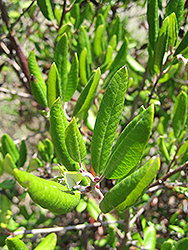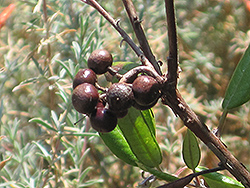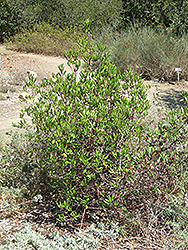Fri & Sat 8am - 8pm
Sun 8am - 7pm
Anytown, USA 12345
fax: 261.787.0463
e-mail: info@successgc.com


Plant Finder

Height: 20 feet
Spread: 15 feet
Sunlight:
![]()
![]()
Hardiness Zone: 7b
Other Names: Arctostaphylos bicolor, Comarostaphylis bicolor
Description:
An attractive, burl-forming shrub or small tree, producing pink to white, lily-of-the-valley like flower clusters in winter, followed by dark red berries in summer; a great water conservation choice, perfect for dry areas
Ornamental Features
Mission Manzanita features showy panicles of pink bell-shaped flowers with white overtones and buttery yellow tips hanging below the branches from early winter to early spring. It has dark green foliage with grayish green undersides which emerges coppery-bronze in spring. The recurved oval leaves remain dark green throughout the winter. The fruits are showy burgundy drupes which fade to dark brown over time, which are displayed from mid summer to mid fall. The peeling dark red bark and crimson branches add an interesting dimension to the landscape.
Landscape Attributes
Mission Manzanita is an open multi-stemmed evergreen shrub with an upright spreading habit of growth. Its average texture blends into the landscape, but can be balanced by one or two finer or coarser trees or shrubs for an effective composition.
This is a relatively low maintenance shrub, and is best pruned in late winter once the threat of extreme cold has passed. It is a good choice for attracting birds, bees and hummingbirds to your yard, but is not particularly attractive to deer who tend to leave it alone in favor of tastier treats. It has no significant negative characteristics.
Mission Manzanita is recommended for the following landscape applications;
- Accent
- Mass Planting
- Hedges/Screening
- General Garden Use
- Container Planting
Planting & Growing
Mission Manzanita will grow to be about 20 feet tall at maturity, with a spread of 15 feet. It has a low canopy with a typical clearance of 1 foot from the ground, and is suitable for planting under power lines. It grows at a slow rate, and under ideal conditions can be expected to live to a ripe old age of 200 years or more; think of this as a heritage shrub for future generations!
This shrub does best in full sun to partial shade. It prefers dry to average moisture levels with very well-drained soil, and will often die in standing water. It is considered to be drought-tolerant, and thus makes an ideal choice for xeriscaping or the moisture-conserving landscape. This plant does not require much in the way of fertilizing once established. It is not particular as to soil pH, but grows best in poor soils, and is able to handle environmental salt. It is somewhat tolerant of urban pollution. This species is native to parts of North America.
Mission Manzanita makes a fine choice for the outdoor landscape, but it is also well-suited for use in outdoor pots and containers. Its large size and upright habit of growth lend it for use as a solitary accent, or in a composition surrounded by smaller plants around the base and those that spill over the edges. It is even sizeable enough that it can be grown alone in a suitable container. Note that when grown in a container, it may not perform exactly as indicated on the tag - this is to be expected. Also note that when growing plants in outdoor containers and baskets, they may require more frequent waterings than they would in the yard or garden.


